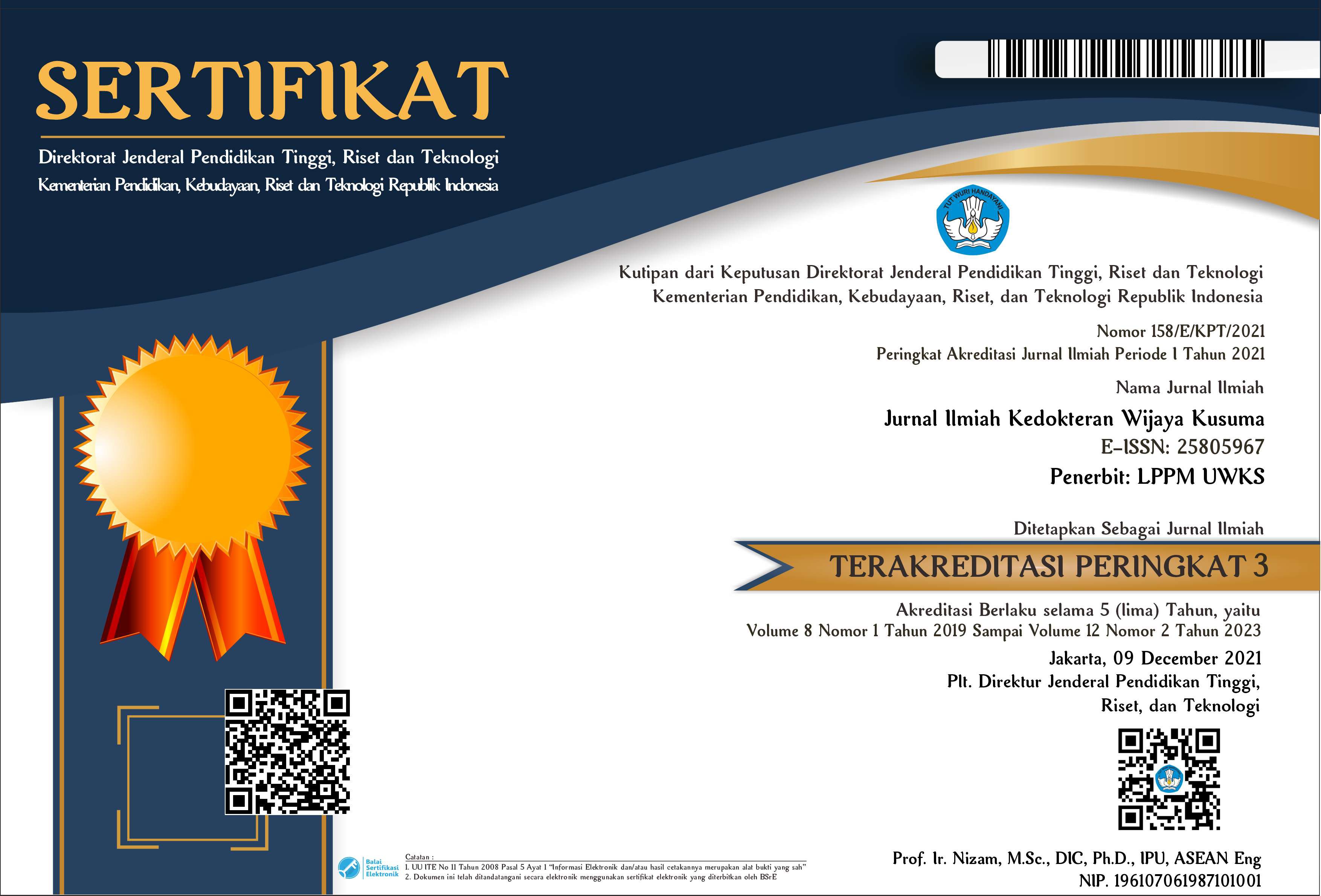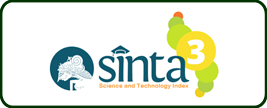Association of Vitamin D Intake in Pregnant Women and Birth Weight
DOI:
https://doi.org/10.30742/jikw.v13i1.2712Keywords:
vitamin D, intake, pregnancy, birth, weightAbstract
Background: Insufficient maternal consumption of vitamin D can have adverse effects on fetal development and increase the likelihood of low birth weight. This research aimed to establish the correlation between the quantity of vitamin D consumed by expectant mothers and the weight of newborns. Methods: This study utilized an analytical observational design with a cross-sectional approach, collecting data from August to November 2022. Information on Vitamin D intake and birthweight was obtained via questionnaire interviews with 96 pregnant women delivering at the University of North Sumatera Hospital or Maharani Women’s and Children Hospital. Semi-Food Frequency Questionnaires (FFQs) served as the data collection instrument. Non-probability consecutive sampling was employed. Statistical techniques, including Chi-square and Fisher's Exact test, were used for data analysis. Findings indicated a prevalence of inadequate vitamin D intake among mothers (3.125%). The mean daily consumption of vitamin D among expectant women was 19.99 μg/day. Mother's education level did not significantly influence the outcome (p=0.589). Results: The results of this study suggest that there was no significant association between maternal age at pregnancy (p=0. 135), gestational age (p=0. 771), parity (p=0958), and baby's sex (p=0. 448) with birth weight. Conclusion: An observed association existed between the prenatal intake of vitamin D and neonatal birth weight in expectant mothers.
References
Anggrenisa Rika. (2018). Faktor-faktor Yang Berhubungan Dengan Beratbadan Bayi Lahir Di Klinik Nurhalma Dan Klinik Pratama Jannah Tembung. Skripsi. Politeknik Kesehatan KEMENKES RI, Medan.
Arora, S., Goel, P., Chawla, D., Huria, A., & Arya, A. (2018). Vitamin D Status in Mothers and Their Newborns and Its Association with Pregnancy Outcomes: Experience from a Tertiary Care Center in Northern India. The Journal of Obstetrics and Gynecology of India, 68(5), 389–393. https://doi.org/10.1007/s13224-017-1067-3
Costanza, J., Camanni, M., Ferrari, M.M. et al. (2022). Assessment of pregnancy dietary intake and association with maternal and neonatal outcomes. Pediatr Res 91, 1890–1896. https://doi.org/10.1038/s41390-021-01665-6
Fajriana, A., & Buanasita, A. (2018). Faktor Risiko Yang Berhubungan Dengan Kejadian Bayi Berat Lahir Rendah Di Kecamatan Semampir Surabaya. Media Gizi Indonesia, 13(1), 71. https://doi.org/10.20473/mgi.v13i1.71-80
Flood-Nichols, S. K., Tinnemore, D., Huang, R. R., Napolitano, P. G., & Ippolito, D. L. (2015). Vitamin D Deficiency in Early Pregnancy. PLOS ONE, 10(4), e0123763. https://doi.org/10.1371/journal.pone.0123763
Hanifah, L. (2009). Hubungan Antara Status Gizi Ibu Hamil Dengan Berat Badan Bayi Lahir (Studi Kasus Di Rb Pokasi). Skripsi. Fakultas Kedokteran Universitas Sebelas Maret, Surakarta.
Hovsepian, S., Amini, M., Aminorroaya, A., Amini, P., & Iraj, B. (2011). Prevalence of Vitamin D Deficiency among Adult Population of Isfahan City, Iran. Journal of Health, Population and Nutrition, 29(2). https://doi.org/10.3329/jhpn.v29i2.7857
Kamaruddin, M., Triananinsi, N., Sampara, N., & RA, A. M. (2020). Karakterisasi DNA Mikrobiota Usus Bayi pada Persalinan Normal yang diberi ASI dan Susu Formula.
Kamaruddin, M., & Sari, N. A. (2019). Persepsi dan pengetahuan mahasiswa akademi kebidanan tahirah al baeti terhadap gizi remaja. Medika Alkhairaat: Jurnal Penelitian Kedokteran dan Kesehatan, 1(3), 114-118.
Khalessi, N., Kalani, M., Araghi, M., & Farahani, Z. (2015). The Relationship between Maternal Vitamin D Deficiency and Low Birth Weight Neonates. In Journal of Family and Reproductive Health jfrh.tums.ac.ir (Vol. 9, Issue 3).
Labh, S. N., & Shakya, S. R. (2014). Application of immunostimulants as an alternative to vaccines for health management in aquaculture. International Journal of Fisheries and Aquatic Studies, 2(1), 153–156.
Meliati, L., Marliana, Y., Husnia, S., Hanafi, F., Kesehatan Kemenkes Mataram Jl Prabu Rangkasari, P., & Cermen Mataram, D. (2016). Hubungan Bayi Berat Lahir Rendah (Bblr) Dengan Kejadian Hipotermi Di Rsud Provinsi NTB. Jurnal Kedokteran Universitas Islam Al-Azhar Mataram, 1(2), 193-202.
Novita Sari Pratiwi, H., Zen Rahfiludin, M., Aruben, R., Kesehatan Masyarakat Universitas Diponegoro, F., Gizi Kesehatan Masyarakat, B., & Kesehatan, F. (2017). Hubungan Asupan Zat Gizi dengan Berat Lahir Bayi (Studi pada Ibu Hamil Anemia di Puskesmas Bulu, Temanggung, Jawa Tengah Tahun 2017) (Vol. 5). http://ejournal-s1.undip.ac.id/index.php/jkm
Palacios, C., & Gonzalez, L. (2014). Is vitamin D deficiency a major global public health problem? The Journal of Steroid Biochemistry and Molecular Biology, 144, 138–145. https://doi.org/10.1016/j.jsbmb.2013.11.003
Pérez-López, F. R., Pilz, S., & Chedraui, P. (2020). Vitamin D supplementation during pregnancy: an overview. Current Opinion in Obstetrics & Gynecology, 32(5), 316–321. https://doi.org/10.1097/GCO.0000000000000641
Rahman, M. M., Miah, S., Tamanna, S., Hosen, M. B., Akter, T., Johra, T. H., Kabir, Y., Zakir, M., & Howlader, H. (2020). Association of Maternal Vitamin D with Neonatal Vitamin D Status and Birth Weight in Urban Population of Bangladesh: A Cross Sectional Study. Acta Scientific PAEDIATRICS , 3(12).
Restrepoâ€Méndez, M. C., Lawlor, D. A., Horta, B. L., Matijasevich, A., Santos, I. S., Menezes, A. M. B., Barros, F. C., & Victora, C. G. (2015). The Association of Maternal Age with Birthweight and Gestational Age: A Crossâ€Cohort Comparison. Paediatric and Perinatal Epidemiology, 29(1), 31–40. https://doi.org/10.1111/ppe.12162
Sakala, N., & Kaombe, T. M. (2022). Analysing outlier communities to child birth weight outcomes in Malawi: application of multinomial logistic regression model diagnostics. BMC Pediatrics, 22(1), 682. https://doi.org/10.1186/s12887-022-03742-z
Salawati, L. (2012). Hubungan Usia, Paritas Dan Pekerjaan Ibu Hamil Dengan Bayi Berat Lahir Rendah.
Suganda, Y. (2021). Hubungan Kadar Vitamin D Pada Ibu Hamil Dengan Berat Bayi Lahir Di Wilayah Kerja Puskesmas Sungai Limau Kab. Padang Pariaman. NTHN : Nan Tongga Health and Nursing.
van den Berg, G., van Eijsden, M., Vrijkotte, T. G. M., & Gemke, R. J. B. J. (2013). Suboptimal maternal vitamin D status and low education level as determinants of small-for-gestational-age birth weight. European Journal of Nutrition, 52(1), 273–279. https://doi.org/10.1007/s00394-012-0327-3
Wang, C., Gao, J., Liu, N., Yu, S., Qiu, L., & Wang, D. (2019). Maternal factors associated with neonatal vitamin D deficiency. Journal of Pediatric Endocrinology and Metabolism, 32(2), 167–172. https://doi.org/10.1515/jpem-2018-0422
Zamal, A., & Manazir, A. S. (2019). Relationship between Maternal Vitamin D Levels and Risk of Low Birth Weight in Term Newborns: A Case Control Study. https://doi.org/10.4172/2572-4983.1000179
Downloads
Published
Issue
Section
License
The journal operates an Open Access policy under a Creative Commons Attribution-NonCommercial 4.0 International License. Author continues to retain the copyright if the article is published in this journal. The publisher will only need publishing rights. (CC-BY-NC 4.0)

















